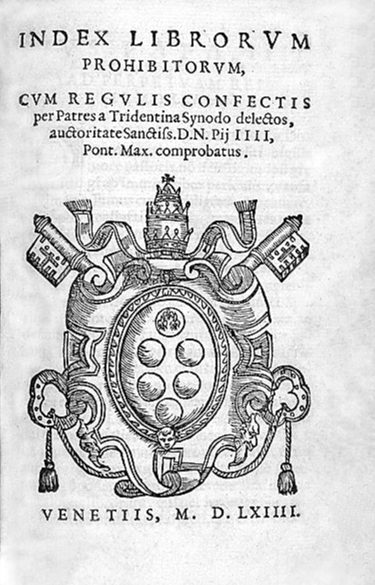Table of Contents
- Introduction
- Burning Books 213 B.C.
- Persecuting Philosophers
- Banned Books & Bible
- Books lost forever
- Inquisition Censorship
- Index Librorum Prohibitorium
- Copernicus & Galileo
- Darkness in Enlightenment
- Revolution & Banned Books
- Colonialism & Book Bans
- New Nation Censorship
- Nazi Germany Book Burning
- USSR Banned Books
- McCarthyism Book Banning
- 21st Century Book Bans
- Banned Books Battles
- Digital Age Book Banning
- World Wide Book Banning
- Book Banning is Bad
- The Future of Book Banning
- Looking Back in History
- Discover New Worlds
Index Librorum Prohibitorum
The Forbidden Pages of the Catholic Church

If there were ever a famous “do not read” list, the Catholic Church’s Index Librorum Prohibitorum would undoubtedly be the most notorious. The Church mission was to protect the faithful from what it deemed heretical and immoral ideas. So, the Church banned a wide array of books, creating a fascinating historical portrayal of religious censorship.
The Index Librorum Prohibitorum, or the List of Prohibited Books, came into being in the 16th century, during the Protestant Reformation. The Catholic Church was battling against the spreading Protestant ideologies. In response, the Church established the Index, a catalog of publications that Catholics were explicitly forbidden to read.
The Index contained various types of books, such as heretical theological works, immoral or indecent literature, and scientific texts that contradicted Church doctrine. These included works by celebrated authors and thinkers, such as Martin Luther, and John Calvin. Later it even included scientists like Galileo Galilei and Rene Descartes. For the Church, the banning of these texts was a way to maintain religious orthodoxy and moral purity among its followers.
Reading a book from the Index was considered a sin, and the consequences could be severe, including excommunication. However, the Church did grant some exceptions. Scholars could request permission to read banned books if their studies required it. This was rare and the Church tightly regulated it.
Church says the sun goes around the earth
One of the most infamous cases of book banning involved the scientist Galileo Galilei. His book, “Dialogue Concerning the Two Chief World Systems,” which presented the heliocentric view of the universe, landed him in trouble with the Church. The Church, holding to the geocentric model, declared Galileo’s book heretical and placed it on the Index in 1633. Galileo himself faced the Inquisition and the Church put him under house arrest for the rest of his life.
Despite its restrictive nature, the Index had varied effects. While it did curb the dissemination of certain ideas within Catholic regions, in many cases, it only sparked curiosity and increased demand for the banned books. Some of these texts found a broader readership in Protestant countries, where the Church’s jurisdiction did not reach.
After four centuries, Pope Paul VI abolished the Index Librorum Prohibitorum was officially abolished in 1966. He was recognizing the need for intellectual freedom and the impracticality of maintaining such a list in the modern world. However, its legacy as a potent symbol of religious censorship persists.